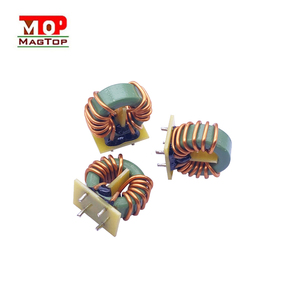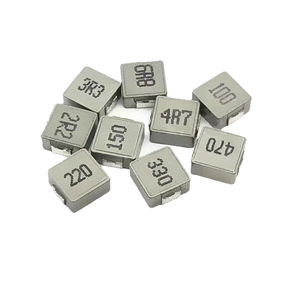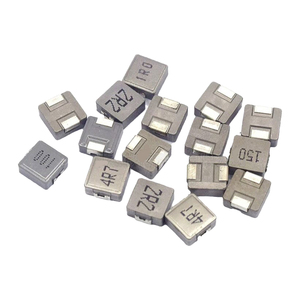
All categories
Featured selections
Trade Assurance
Buyer Central
Help Center
Get the app
Become a supplier

(1287 products available)

























SMD molding power chokes come in different types, each designed to suit specific applications and operational requirements. The primary difference between these components lies in their construction, inductance values, current-carrying capacities, and magnetic core materials. Understanding the various types is fundamental for selecting the appropriate choke for a particular electronic circuit application. Key categories include the following.
As the name implies, double-molding power chokes have two layers of magnetic cores to increase inductance, saturation current capability, and efficiency. This design is beneficial in power applications that require high current and superior electromagnetic interference (EMI) suppression. It is used in DC-DC converters, power amplifiers, and high-performance power regulation circuits.
These chokes are designed to handle larger currents than standard power chokes. They usually feature enhanced thermal dissipation properties and a higher saturation current to deal with increased electrical load without losing inductance. These are often found in server power supplies, industrial electronics, and heavy machinery.
This power choke is characterized by a cylindrical shape. This variation in shape influences its magnetic flux distribution and, in turn, inductance value. Cylindrical molding power chokes are employed in applications where space is limited yet require efficient energy transfer. Used in compact electronic devices, such as medical equipment and consumer gadgets, this cylindrical molding power choke is especially relevant when design and space constraints are equally significant.
This type is a bar-shaped inductor encased in a molded material. The shaped magnetic core helps in offering a controlled inductance value. Increasing the efficient energy transfer mechanism ultimately results in better device functionality. Such chokes are often found in power supply circuits, amplifiers, charging systems, and devices where stable power is necessary.
Compact and effective, these electronic components find function across many sectors, primarily due to their ability to provide inductance in miniaturized forms.
The SMD molding power chokes are used extensively in this industry, especially in smartphones, tablets, laptops, and other gadgets. Any gadget's power management systems, including DC-DC converters and voltage regulation modules, require these to maintain efficient power transfer and reduce noise.
SMD molding power chokes help in providing stable power supplies for high-speed data transmission equipment and base station power amplifiers. They also play an important role in eliminating signal noise in devices used in this industry.
With the increased use of electronic systems in modern automobiles, these power chokes have become essential components. In automotive applications, they perform functions such as power supply regulation for infotainment systems, navigation, and advanced driver-assistance systems (ADAS) to maintain stability and reliability.
In industrial machinery power management, SMD molding power chokes are used in heavy equipment, robots, control systems, and power supply units. They smooth power transmission, reduce inductive loads, and enhance energy efficiency in motors and large machinery systems.
These SMD power chokes are crucial in medical diagnostics and monitoring equipment. Power chokes help ensure that devices such as imaging systems, diagnostic equipment, and patient monitoring systems receive stable and interference-free power while adhering to strict regulatory standards for safety and precision. This regulation minimizes power fluctuations that could otherwise affect device performance and contribute to patient safety.
LED lighting solutions, including commercial and residential lighting systems, also use these power chokes with voltage regulators and constant-current LED drivers. This device helps maintain steady current flow to LED arrays, thus maximizing brightness, energy efficiency, and lifespan while reducing heat and flicker.
Some of the features and specifications, as well as the structural details, of the SMD molding power chokes, are discussed here. Thus, one understands these electronic components better and how they differ.
Inductance Values
The primary function of these power chokes is to store electrical energy in an electromagnetic field via inductance. It is typically measured in microhenries (μH). The desired inductance value in a given application determines the power choke's intended use.
High Saturation Current
These chokes are designed to withstand large currents without saturating. Once it saturates, the component will lose its inductive properties and affect circuit performance. These high-current chokes are generally used in power supplies and DC-DC converters where high current is common.
EMI Suppression
Provided by the power chokes is essential in sensitive electronic devices. These chokes reduce electromagnetic interference, allowing smooth signal transmission while suppressing noise for better performance and function.
Compact Size and SMD Design
These chokes are preferred for their compact size as they are easy to mount on the surface. This design is especially useful in consumer electronics, automotive, and telecommunication systems where space is a vital consideration for the functionality of integrated circuits.
Prepare the PCB
The area where the power choke will be placed must be cleaned and prepared. Ensure no debris or old solder is on the pad.
Align the Choke
For an accurate placement, the SMD molding power choke should be positioned on the designated pad on the PCB.
Soldering
While some low-inductance power chokes may require additional soldering, others come with self-adhesive mounting that might need just a few soldering points for secure placement. If needed, use a soldering iron or reflow oven to ensure proper solder joints.
Testing
Once the installation is complete, the SMD molding power choke must be electrically checked to warrant good connectivity and functionality.
Regular Inspection
Visually check the chokes for any evident damage. Thermographic analysis might be required for identifying internal issues, such as overheating. This will help assess the SMD molding power choke's overall health.
Heat Management
Proper heat dissipation via fans, heat sinks, or other cooling methods can maintain the longevity of these components. This reduces the chances of wear out and failure over time and thus keeps the device functional with minimal downtime.
Shielding and EMI Filters
Occasionally replace or update the choke's shielding or EMI filters to reduce interference. This will help in maintaining the efficiency and longevity of the product.
Testing
Measure the inductance and resistance periodically to check if the values are within acceptable ranges. Consider using LCR meters, oscilloscopes, or other specialized equipment to ensure the parameter values are correct.
There are some quality-related issues that the SMD molding power choke faces. Quality-related considerations can also influence the level of performance and safety associated with these devices.
Only premium-grade materials should be used for the construction of these chokes. Such materials ensure that the chokes can sustain the required electromagnetic stresses to function effectively. Poor materials will affect the product's electromagnetic shielding and heat dissipation properties, increasing the risk of component failure and reducing performance. Ultimately, this can even affect the safety of whole systems, especially in high-drain or critical applications.
Failure of these power chokes can result in unsafe operating conditions in devices, especially in high-power applications. For example, in automobiles, the failure of an automotive electric choke can create power surges in the system, affecting other electrical components. In server racks or industrial equipment, failure may cause voltage irregularities that could fry adjacent circuits.
It's also essential to consider whether these power chokes meet any internationally accepted quality standards, such as ISO, CE, or UL. Complying with these standards ensures that the manufacturers have gone through certain quality and safety procedures, thus assuring the product's reliability. SMD molding power chokes may undergo mechanical stress during installation or in rugged end-use environments. Thus, thorough vibration and shock testing is important to ensure they can operate securely without risk of failure.
Bad solder joints or improper mounting can create severe issues with electrical connectivity. It can also cause mechanical stress on the choke, leading to catastrophic failures down the line. Thus, care should be taken during installation. Proper soldering techniques, as well as the use of reflow ovens or professional soldering equipment, can make the first step toward achieving this goal.
Every SMD molding power choke has certain limitations regarding the applications they can be used in. Overloading a choke beyond its rated inductance or current carrying capacity can cause it to saturate, destroying the device and causing a cascading effect that could compromise the safety of equipment. For example, in medical devices or aerospace systems where these components are commonly found, adhering to these limits is paramount to maintaining reliable performance while ensuring safety and preventing damage to both the equipment and the patient monitoring systems.
The main advantage of SMD molding power chokes over traditional inductors is their compact size and effective electromagnetic interference suppression. In addition, these chokes are efficient voltage regulation components frequently used in modern power management systems across automotive, telecommunications, and consumer electronics.
These chokes are most widely used in - automotive, telecommunication, and industrial sectors - to enhance power supplies, smooth voltage fluctuations, and reduce noise in high-frequency switching circuits.
Usually, ferrite and iron powder cores are the two most common types of magnetic material used in these chokes. They vary in terms of their magnetic permeability, inductance value, saturation current, and efficiency in noise suppression.
The inductance value is affected by the magnetic core material, the number of windings, and the physical geometry of the device. For example, increasing the number of winding will increase the inductance, while a larger core will boost it further.
The key features of these molding power chokes are - compact size, high inductance, good saturation current, and effective EMI suppression capability.